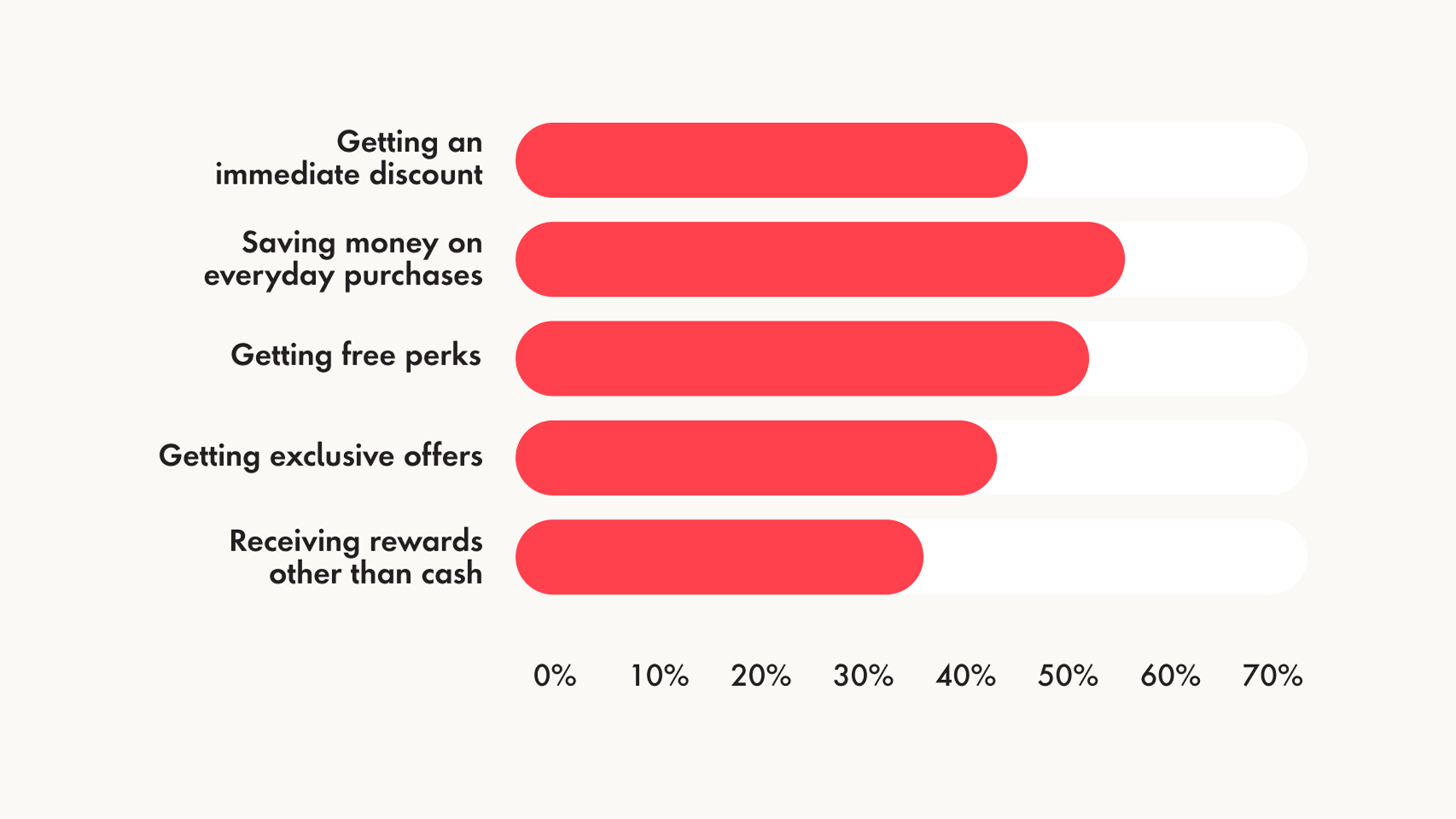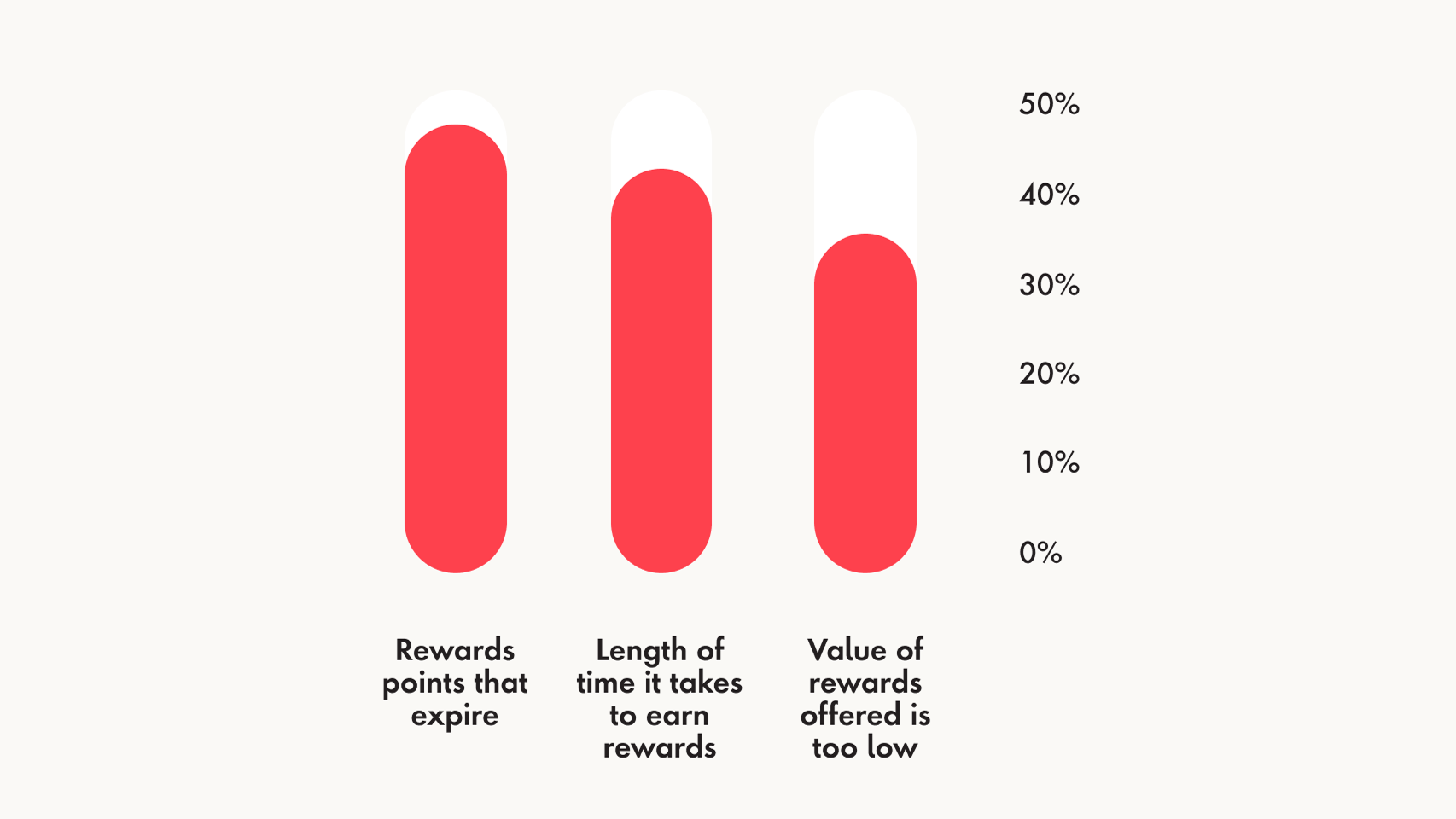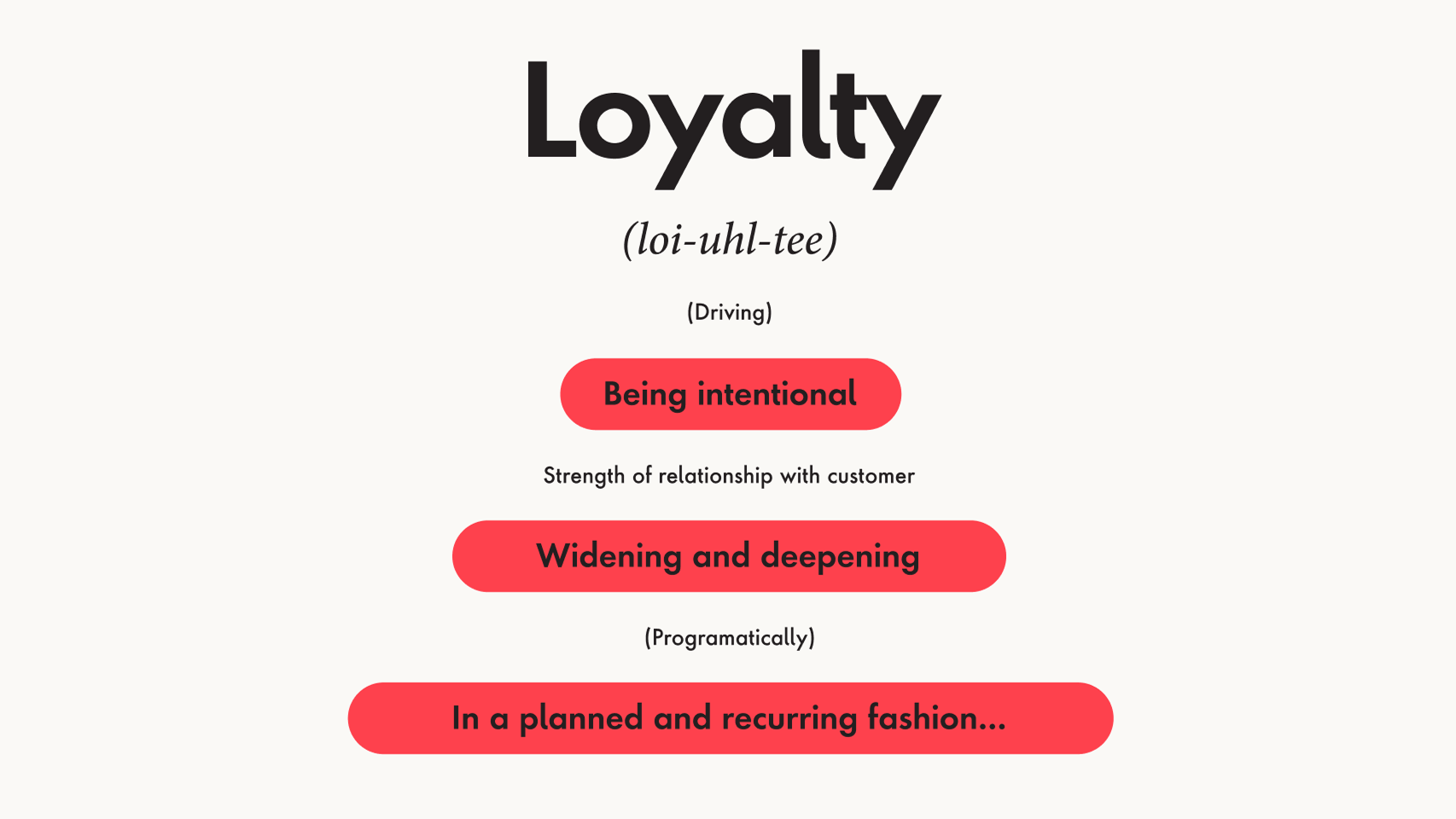What issue can we solve for you?
Type in your prompt above or try one of these suggestions
Suggested Prompt


Where Points Miss the Point with Customer Loyalty and Engagement


Why do buyers stick with certain brands?
Why do buyers stick with certain brands? It’s simple: they find ongoing value at a price they are willing to pay. Yet, that’s not how many marketers are continuing to manage their loyalty programs. Instead, they’re stuck in a loop, banking on rewards points and mediocre discounts that customers often forget about. Loyalty programs today are missing the mark, becoming stale and ineffective due to a failure to grasp what truly drives loyalty: a consistently fulfilled brand promise within a unified customer experience that makes it easy to make a purchase or and targeted loyalty benefits that solve a problem.
As consumers face endless choices and incentives for switching brands, businesses need to deliver more than just value-focused perks. Instead, they should focus on capturing a consumer’s wallet, heart and mind to deliver on brand promises through cohesive experiences that make life simple and meaningful. This approach elevates your company from a mere provider of products or services to a trusted, valuable and indispensable partner in the customer’s everyday life. Building this type of emotional connection and creating more benefits that target your customers’ needs and pain points, can help to build true loyalty in a far more cost effective manner than “earn and burn” loyalty programs.
Figure 1
What motivates customers to join a loyalty program?

Source: Cordial (2023). B2C marketer data sample sourced by Dynata (n=500)
Figure 2
Top 3 loyalty program frustrations

Source: Cordial (2023). B2C marketer data sample sourced by Dynata (n=500).

Want to see the benefits of customer loyalty? Start by building strong customer relationships
Brands face a loyalty paradox. While consumers reportedly admit to actively using just two or three of the average of 12 loyalty programs they subscribe to, they also expect to be rewarded for their loyalty. Consumers also cite saving money on everyday purchases (58 percent) and getting free perks (56 percent) as the biggest motivators for joining a program (fig. 1). But what about inspiring them to remain loyal?
Brands need to become indispensable to their customers. They can do this by: 1. being intentional; 2. widening and deepening customer bonds and designing a superior experience that addresses pain points—which include rewards that expire, take a while to accumulate and aren’t valuable to the consumer—and delivers value to customers (fig. 2); and 3. doing it in a planned and recurring fashion.
This is where Amazon gets it right. Its Prime offering, though not specifically positioned as a loyalty program, steadily generates repeat purchases from retained customers, a primary measure of loyalty. The result? Prime customers spend $1,600 annually vs. non-Prime customers who spend $600 With its Prime offering, Amazon becomes a larger, more integral part of the buyer’s lifestyle and in the process, gets a higher share of wallet in more categories.
Equinox Fitness takes a similar lifestyle approach to loyalty. When a fitness club member—let’s call them Jane—refers another member, the business rewards her with a gift card that entitles her to a choice of a free personal training session, a spa treatment or sports apparel from the club’s shop. The company’s app even makes it easy for Jane to trial a broader set of services, schedule a massage, track her fitness goals or reserve a spot in an upcoming cycle class. This not only elevates the program above a simple earn and burn system, but also further integrates her into Equinox’s ecosystem of offerings. And the more programs she is involved in the less likely she is to cancel her membership. It’s easier to walk away from a treadmill that’s nearly identical to the gym down the street. It’s harder to walk away from a trainer who is giving your personalized guidance to hit your goals.
When Jane asks the club manager to suspend her membership because she’s expecting a child, the manager introduces her to special classes designed for women just like her, inviting her to join a community of women that share mutual interests and experiences.
Jane cancels her suspension, then refers a friend who is also pregnant, and her participation in the club’s loyalty ecosystem begins all over again. Jane goes on to advocate the club to friends, family and peers on Yelp and Facebook, sharing how Equinox has become a regular component of her daily routine and lifestyle. As a result, two of her office colleagues join the club through its corporate discount program.
Jane has reached the pinnacle of the two-way, mutually beneficial relationship, one with a strong emotional bond at its core. Now, Equinox isn’t just her fitness club; it’s part of her lifestyle. She also leverages the club’s convenient features through its multiple channels of interaction. But what is even more valuable: she brings others with her through her love for the brand.
As a result, Equinox now only earns more share of Jane’s wallet, but it also becomes a more valued part of her life. In the past, the club would have rewarded Jane’s referral with short-lived perks like a free month of dues. Yet by using the referral as an opportunity to broaden and deepen its relationship with Jane, the club plays a more prominent role in her daily routine and lifestyle.
Loving a favorite brand through advocacy is a growing measure of loyalty
The upside revenue from loyal advocates that express their brand love through word-of-mouth (“I can’t imagine life without Costco”) is encouraging many businesses to operationalize word-of-mouth marketing. According to several studies, when loyal advocates create emotional bonds with their favorite brands, those customers consistently generate higher lifetime value—they spend twice as much as the average customer and are four times as likely to share information about their favorite brand. And, the customers that advocates refer are 37 percent more likely to be retained. In a pre-digital world, brand advocates shared their story with four or five people. Today, social networks empower customer advocates to potentially share their love with thousands of peers, making them some of the most effective salespeople.
Social media influencers do this at scale. They’ve changed the e-commerce game, becoming a significant advocate connecting consumers to brands. And their influence has only grown. Between 2020 and 2025, influencers’ market size grew threefold to $32 billion.
Loyalty managers in these brands find the social sites and tactics their advocates use most to critique or recommend them. They also deploy listening and analytics to validate the impact of social networks on revenue.
So, what can you do to inspire this kind of devotion amongst your customers?
Understand your customers
To really connect with customers, you need to lean into one of your most powerful tools: data. Why is it so powerful? Because it empowers you to understand your customers so that you can craft the right strategies that will resonate with them.
By analyzing customer data, brands can offer personalized experiences through multiple touchpoints, adapting to their customers’ changing needs and tastes. This lets you create experiences that feel tailor-made to inspire ongoing loyalty.
This data-driven approach isn’t just about understanding what customers want today; it’s also about predicting and preparing for what they want tomorrow.
This is especially true when it comes to a generation that you really need to know: Generation Z (Gen Z), the future of business. Over the past several years, this generation of digital natives has been transforming business-customer relationships, pushing its expectations for consistent, service-driven experiences. Bank of America estimates that the generation is on track to accumulate $74 trillion in income by 2040, making them a significant economic engine.
To remain loyal, members of Gen Z demand regular engagement as well as opportunities to interact with the brand. This generation also prefers brands that support and recognize the causes they care about. And, they don’t differentiate between online and offline experiences.
There are no holds barred with Generation Z: They share their feelings and experiences, not just with each other but with retailers. No topic is off limits. Feedback ranges from preventing changes to brand logos to admonishing retailers for mistakes and inefficient operations. All of this feedback provides crucial, data-driven insights that brands can you to inspire loyalty. Gen Z’s zeal to be involved goes beyond the shopping experience–as they participate in the design of product and services, even the ways the brand conducts itself.
In short, any successful loyalty program that wants to be future-ready needs to meet Gen Z on their own terms. And you can use data to understand not only Gen Z, but every single one of your customer segments. Data insights are the toolkit you need to build stronger, more personalized loyalty programs that are dynamic, versatile and in tune with your evolving customer base.
Prioritize convenience
Convenience is king. Companies that prioritize ease and efficiency in their customer interactions position themselves ahead of the competition. What does this mean? It means simplifying everything from the browsing experience to the checkout process, whether it’s through intuitive mobile apps, seamless online interfaces or real-time booking solutions.
Adoption of voice-activated assistants (Amazon’s Alexa, Google Assistant, and Apple’s Siri) provides another level of convenience by making it easier to do business. And consumers are by-and-large on board with this trend. SoundHound found that 77 percent of surveyed drivers in the United States would rather use in-car voice assistants to place a to-go food order rather than using drive-through.
Make customer loyalty metrics an initiative across functions
Managing loyal customers is often the job of the marketing department, even though the strength of the customer relationship should also be measured by call center interactions, negative social media posts about an in-store experience or the actions of brand advocates which many marketers never see. As a result, out-of-date processes and organizational silos miss opportunities to recognize true customer loyalty.
While every industry and company is different, take a look at all of the customer actions your company should be using to assess true loyalty. For example, a company that identifies a customer as loyal that continues to buy out of sheer habit, won't recognize early warning signs that they may be at risk.
What can you do today to inspire and track loyalty?
So, what are the strategies that actually work? Here’s what you can do to up the ante on your loyalty plans:
1. Reward incremental engagement, not assumed behavior
Rewarding customers for what they’ll do anyway isn’t going to help the top or bottom line. Instead, use your knowledge of customers to introduce them to a new product category or a new shopping opportunity. Rather than reward customers for sustaining a habitual use, a quick-service restaurant might find that a more effective alternative might be to earn their loyalty with a new breakfast sandwich or an invitation to “happy hour,” recognizing their exploratory behavior, which paves a path to growth.
2. Don’t limit loyalty to a single metric
Connected experiences that conveniently open doors to a wide array of choices, buttressed by recommendations and opinions of our peers, have also created new levels of transparency that make it tough to hide from unhappy customers. This same transparency, however, makes it easy to recommend a favorite brand, for which we’ve pledged our loyalty to friends and family. The resulting loyalty ecosystem presents a range of metrics we can use to measure the strength of a relationship. Share of wallet, mind and life represents a more modern composite score, built with data science techniques.
3. Move beyond pure points-based or value-based programs
You may need a value hook to spur signup and generate initial interest. But long-term loyalty is built through compelling benefits that build brand affinity and make the overall experience for the customer easier and more enjoyable. They help make your brand indispensable instead of a complex system of discounts.
4. Don’t be afraid of emerging technologies
A lot of innovation has occurred from thousands of vendors that participate in the giant customer relationship management (CRM) market. Some solutions make programs more seamless, like “cards” in a mobile wallet or points earned through credit/debit cards. And many retailers are finding success through an “exchange” method—an e-commerce site may let consumers pay with Amex points for example (which acts as advertising for partners). Other retailers are personalizing offers or offering extra perks based on purchasing patterns. And many companies are leaning on leading software players like Aimia, Brierley and CrowdTwist to create something unique to their business. Consider vendors that help marketers benefit from conversational commerce such as Cognitive Code, Drastin, noHold or Semantic Machines.
There’s no single absolute truth when it comes to measuring loyalty
Measuring the strength of relationship with customers requires multiple perspectives. Wallet share, mind share and heart share are composite scores built using data science techniques. This removes the blind spots of a single set of metrics and more quickly pinpoints the underlying change needed in the ecosystem.
Learn how you can get more share of wallet, mind and heart
To learn how you and your cross-functional team can benefit from our new measurement techniques for assessing the strength of relationships that generate more share of wallet, mind and heart, contact Publicis Sapient today.



